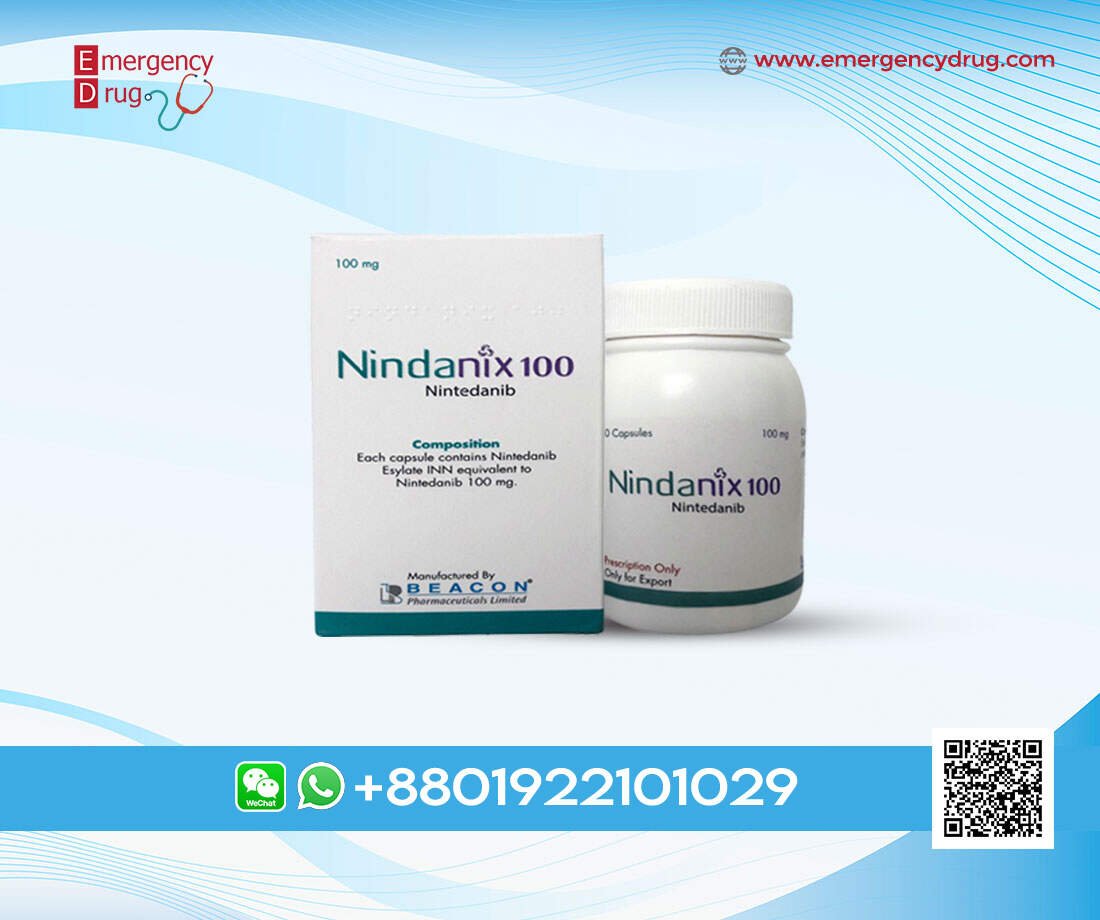
Ponaxen (Ponatinib) 45 MG – 30 Tablets
Price: $410.00
Product Feature:
| Manufacturer | : Everest Pharma Ltd. |
| Indication | : Chronic lymphocytic leukemia |
| Strength | : 45 mg |
| Quantity | : 30 Tablets |
| Storage | : Below 30°C |
| Registrations | : Export Only |


Description
Ponaxen (Ponatinib) use to treatment different types of chronic myeloid leukemia (CML; a type of cancer of the white blood cells), including treatment in people who can no longer benefit from other medications for CML or who cannot take these medications because of side effects. Ponatinib also use to treat different types of acute lymphoblastic leukemia (ALL; a type of cancer of the white blood cells) in people who can no longer benefit from other medications for leukemia or who cannot take these medications because of side effects. Ponatinib like a class of medications call kinase inhibitors. It blocks the action of an abnormal protein that signals cancer cells to multiply. This prevent stop the spread of cancer cells.
Using of Ponaxen
Ponatinib comes as a tablet to take by mouth. It is usually taken once a day with or without food. Take ponatinib at around the same time every day. Follow the directions on your prescription label carefully, and ask your doctor or pharmacist to explain any part you do not understand. Take ponatinib exactly as directed. Do not take more or less of it or take it more often than prescribed by your doctor.
Swallow the tablets whole; do not split, chew, or crush them.
Your doctor may need to delay your treatment, adjust your dose, or permanently stop your treatment of ponatinib depending on your response to treatment and any side effects that you experience. Talk to your doctor about how you are feeling during your treatment. Continue to take ponatinib even if you feel well. Do not stop taking ponatinib without talking to your doctor.
Other uses Ponaxen
This medication may be prescribed for other uses; ask your doctor or pharmacist for more information.
Special precautions
Before taking Ponaxen ,
- Tell your doctor and pharmacist if you are allergic to ponatinib, any other medications, lactose, or any of the ingredients in ponatinib tablets. Ask your pharmacist or check the Medication Guide for a list of the ingredients.
- What other prescription and nonprescription medications, vitamins, nutritional supplements, and herbal products you are taking or plan to take. Be sure to mention any of the following: ketoconazole (Nizoral); medications to reduce stomach acid, such as lansoprazole (Prevacid); and rifampin (Rifadin, Rimactane, in Rifamate, in Rifater).
- If you have or have ever had a bleeding problem; diabetes; pancreatitis (swelling of the pancreas, a gland behind the stomach that produces substances to help with digestion); or if you are lactose intolerant (inability to digest dairy products). Also, tell your doctor if you drink or have ever drunk large amounts of alcohol.
- You should know that ponatinib may decrease fertility in women. However, you should not assume that you or your partner cannot become pregnant. Tell your doctor if you are pregnant or plan to become pregnant. If you are female, you will need to take a pregnancy test before you start treatment. You should use birth control to prevent pregnancy during your treatment with ponatinib and for 3 weeks after you stop taking the medication.
- If you are breastfeeding or plan to breastfeed. You should not breastfeed while taking ponatinib and for 6 days after your final dose.
- If you are having surgery, including dental surgery, tell the doctor or dentist that you are taking ponatinib. If you are scheduled to have surgery, your doctor will tell you to stop taking ponatinib for at least 7 days before the surgery or procedure. Your doctor will tell you when to start taking ponatinib again after your surgery.
Special dietary instructions
Do not eat large amounts of grapefruit or drink grapefruit juice while taking this Ponaxen .
If forget a dose
Take the missed dose as soon as you remember it. However, if it is almost time for the next dose, skip the missed dose and continue your regular dosing schedule. Do not take a double dose to make up for a missed one.
Side effects
Ponaxen may cause side effects. Tell your doctor if any of these symptoms are severe or do not go away:
- Rash
- Dry skin
- Diarrhea
- Constipation
- Hair loss
- White patches or sores on the lips or in the mouth and throat
- Loss of appetite
- Weight loss
- Cough
- Difficulty falling asleep or staying asleep
- Back, bone, joint, limb, or muscle pain.
Serious Side Effects
Any of these symptoms or those listed in the IMPORTANT WARNING section, stop taking immediately or get emergency medical treatment:
- Unusual bruising or bleeding
- Bloody or black, tarry stools
- Unusual vaginal bleeding or heavier than usual menstrual bleeding
- Vomit that looks like coffee grounds
- Frequent nose bleeds
- Coughing up blood
- Dry, red, painful, or irritated eyes
- Sensitivity to light
- Blurred vision, floaters, double vision, or other vision changes
- Wounds that do not heal
- Fever, sore throat, chills, or other signs of infection
- Changes in taste; muscle weakness; drooping eyelids or part of face; tingling, burning, pain, or loss of feeling in hands or feet
- Headache, seizures, confusion, problems thinking, or changes or loss of vision
- Extreme tiredness or weakness
- Swelling of your face, hands, feet, ankles, or lower legs
- Pain, swelling, or tenderness in the abdomen (stomach area)
- Ongoing pain that begins in the stomach area but may spread to the back
Ponatinib may cause other side effects. Call your doctor if you have any unusual problems while taking this medication.
If you experience a serious side effect, you or your doctor may send a report to the Food and Drug Administration’s (FDA) MedWatch Adverse Event Reporting program online.
Storage and disposal
Keep this Ponaxen in the container it came in, tightly closed, and out of reach of children. Store it at room temperature and away from excess heat and moisture (not in the bathroom).
It is important to keep all medication out of sight and reach of children as many containers (such as weekly pill minders and those for eye drops, creams, patches, and inhalers) are not child-resistant and young children can open them easily. To protect young children from poisoning, always lock safety caps and immediately place the medication in a safe location – one that is up and away and out of their sight.
Unneeded medications should be disposed of in special ways to ensure that pets, children, and other people cannot consume them. However, you should not flush this medication down the toilet. Instead, the best way to dispose of your medication is through a medicine take-back program. Talk to your pharmacist or contact your local garbage/recycling department to learn about take-back programs in your community.
Symptoms of overdose :
- Fever, sore throat, chills, and other signs of infection
- Rapid, irregular, or pounding heartbeat
- Tiredness
- Chest pain
For any inquiries please contact us
For more Oncology medicine, visit our SHOP












Reviews
There are no reviews yet.